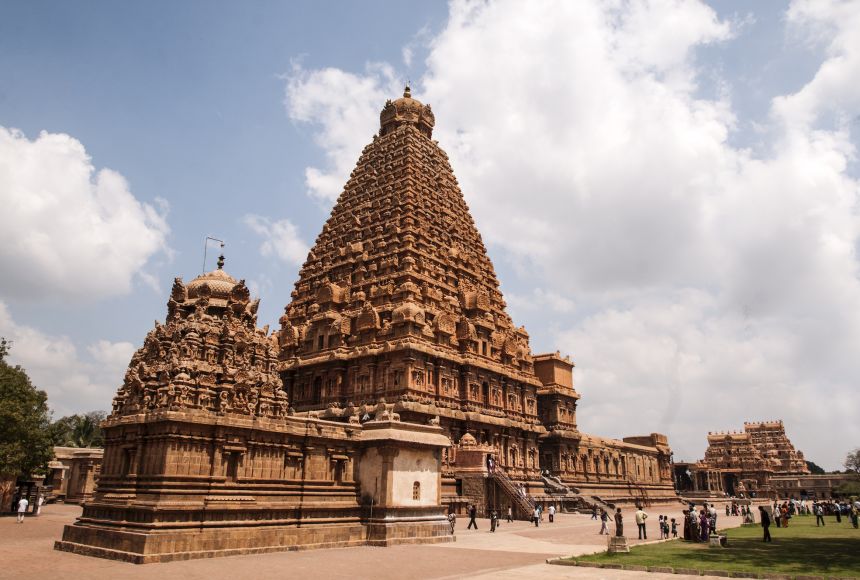The Three Crowned Kings of Tamilakam ruled and fought over the southern region of the Indian subcontinent for centuries. At the beginning of the common era, southern India and Sri Lanka were home to three Tamil dynastic chiefdoms or kingdoms, each ruled by kings, together called “muvendar.” The Pandya, Chera, and Chola dynasties ruled over the Tamil people during ancient and medieval India, fighting among themselves and other forces for dominance of the region. Despite this turmoil, they were crucial in advancing south Indian art, architecture, and literature.
The Tamil people are a linguistic group with roots in modern south India and Sri Lanka, although many have emigrated out of this region. The traditional homeland of the Tamil people is called Tamilakam, or Tamil Nadu. Tamil is one of the oldest languages of the Indian subcontinent. Archaeological and written evidence suggests there were strong trade and economic links between Tamilakam and Mediterranean powers like Rome. Tamilakam is an important historical region for early Hinduism, and Shiva worship was particularly prominent during the period of the Three Crowned Kings. Shiva—known as the destroyer of the universe—is a Hindu god, one of the trio of the Hindu pantheon alongside Brahma and Vishnu. Many ancient Tamil were part of the Shaivism sect of Hinduism, worshiping Shiva as their main god.
The Pandya Dynasty
The Pandya are the earliest mentioned of the Tamil ruling chieftains. They first appeared in Greek writings in the fourth century B.C.E. and were said to have sent ambassadors to Roman emperors. The Pandya rulers governed the most southern part of the Indian subcontinent and initially practiced Jainism, but later became Hindus, specifically Shaivas.
The main city of the Pandyas was Madurai, where Tamil kings held three Sangam poetry academies. There, scholars produced much of the unique Tamil literature from this period. The symbol of the Pandya Dynasty was the fish. After ruling southern India for centuries, infighting and Islamic invaders weakened the dynasty, which eventually ended around the 16th century C.E.
The Chola Dynasty
Chola rulers held the eastern coast of southern India and Sri Lanka, becoming prominent in the 10th through 13th centuries C.E. They were based in the Cauvery valley, in the cities of Tanjore (Thanjavur) and Uraiyur. They first appeared in non-Tamil records in the third century B.C.E., in stelae inscriptions from the Mauryan King Ashoka the Great, who held territory to the north of Tamilakam. Chola rulers used the symbol of a tiger as their royal emblem.
While they existed in conflict with other neighboring tribes like the Pandyas and the Pallavas, eventually, King Rajaraja (reigned 985–1014 C.E.) took the empire to its height. He conquered the Maldive Islands and parts of Sri Lanka during the 10th century C.E. To celebrate his victories and reign, he commissioned the Brihadisvarar Temple at Tanjore, completed in the early 11th century C.E. This temple was one of the tallest temples in medieval India at about 60 meters (197 feet), and it was dedicated to the Hindu deity Shiva.
Eventually, the Chola Dynasty was defeated by the neighboring Pandya Dynasty and the rule of the Cholas ended in 1279. The Chola rulers, like the other Tamil groups, were mostly practitioners of Hinduism. However, other religious groups such as Jainism, Islam, and Buddhism were also found in Tamil society.
The Chera Dynasty
The Chera chieftains governed the southwestern coast of Tamilakam, reaching their height in the ninth century C.E. The first rulers were mentioned in Sangam literature in the first century C.E. The city of Karur served as their capital. The Chera were known for their jewel and spice trade, and their royal emblem was the bow. The modern district of Kerala draws its name from the Chera Dynasty.
Legacy of Ancient Tamilakam
Writers and poets composed the earliest surviving Tamil literature during this period. Sangam writings were composed in the Tamil language and often featured poems written about royalty and love, with both men and women as primary characters. Some of the poems were also composed by women. Sangam writings were supposedly created at the centers of learning in Madurai, part of Pandya territory. The Sangam period began in the fourth century B.C.E. and ended in the fourth century C.E. Sangam (also called cankam) poems and writings are one of the oldest records of Tamil literature, legends, and language.
Tamilakam in southern India and Sri Lanka has a rich history. The Pandya, Chera, and Chola rulers rose and fell in conflict with each other but also allowed for art and literature to develop and flourish. Ancient Tamil kingdoms had important trade routes in the Mediterranean and even sent ambassadors to Roman courts. They were important cultural and religious centers not only for Tamil people but for Hindu practitioners across India and Sri Lanka.
